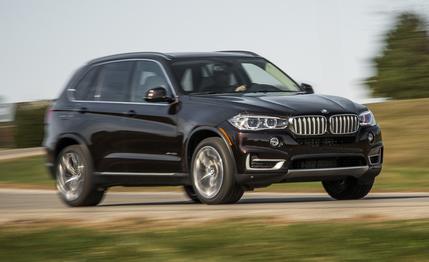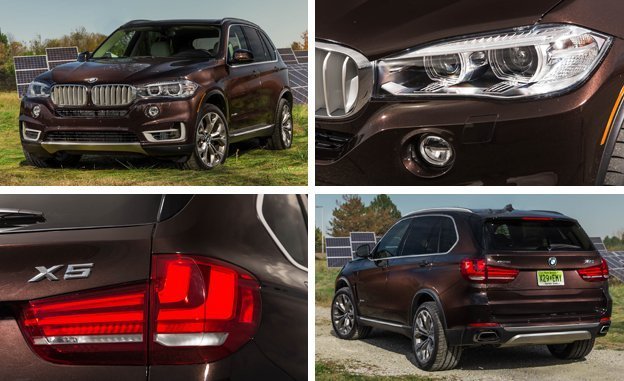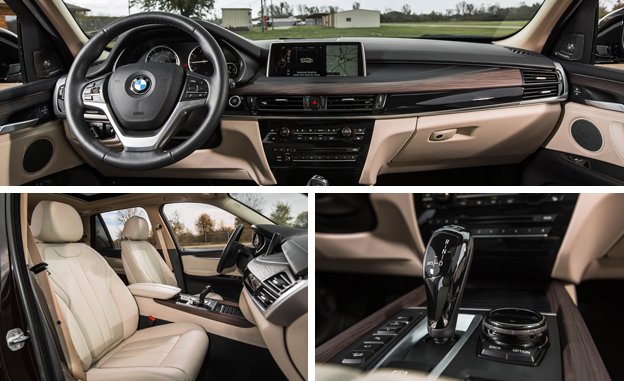
 Instrumented Test
Instrumented Test
The first thing you need to know about the new plug-in-hybrid version of the BMW X5 is that the EPA rates its electric-only range at just 14 miles—and, of course, your results may vary. Which is another way of us saying that you’ll need good luck to go even that far between charges.
So you shouldn’t expect the X5 xDrive40e to be a Chevy Volt writ large. Commuting on electricity is possible only for those who have a very short drive. A 14-mile range would be just enough to allow you to traverse Manhattan from north to south (or vice versa), assuming mild traffic. Plus, the top speed in EV mode is 75 mph, so if your commute includes any expressway driving, you’re better off selecting the Save Battery mode and reserving the EV driving for city streets. Also, in EV mode the X5 xDrive40e needs 22.6 seconds to reach 60 mph. That is just 0.8 second quicker than a 2011 Smart Fortwo ED. And it should be noted that using the inline-four to charge the battery (as also occurs in Save Battery mode) is hardly an efficient practice.


If saving dollars at the pump is your goal, leave the X5 in Auto eDrive (hybrid) mode and plug it in as often as you can. We averaged just 21 MPGe, which is lower than expected. To be fair, our result may have been slightly dragged down due to a few drivers using the engine to charge the battery in order to experience the EV mode. By comparison, an X5 xDrive35d returned 25 mpg in our hands. The diesel also boasts a 6-mpg advantage in the EPA highway ratings, at 31 mpg versus the 40e’s gasoline-only 25-mpg score (the diesel also has a 1-mpg-higher EPA city rating of 24 mpg). The diesel also is $4400 less expensive. But diesels don’t have the eco-friendly cachet of a plug-in hybrid, especially now.
The X5 40e is a very conventional hybrid setup. It pairs a 2.0-liter turbocharged inline-four with a 111-hp electric motor and an eight-speed automatic. The engine on its own makes 240 horsepower and when combined with the motor can deliver up to 308 horses, which is very close to the turbocharged inline-six that powers the X5 35i. But whereas the 35i’s engine must motivate 4934 pounds, the 40e’s batteries mean it’s saddled with 5283 pounds—thus, the 40e trails the 35i to 60 mph by two-tenths, at 6.2 seconds.
That difference, however, is largely irrelevant in everyday driving. There’s never a feeling that a measly 2.0 liters isn’t enough; the X5 40e has more than adequate power. Plus, the hefty five-seater is dynamically sound. It carries its weight well, pitching and rolling like any big SUV, but without the extra commotion associated with poorly tuned dampers. This is no back-road carver, but it’s not supposed to be.


Its only dynamic failing is a spongy brake pedal that requires some concentration for smooth stops. When are makers of hybrids going to figure out that a blended brake system isn’t the way to go? There are settings in modern cars for everything; why not have a regenerative setting (as in the all-electric Tesla Model S) and have the brake pedal solely operate the mechanical stoppers? It makes sense to us.
One of the best things the X5 has going for it is the seating position. The current generation may have lost a little of that truly commanding feeling—you know, when the car’s beltline is nearly on the same plane as your own—but visibility is great for a big ute. And this large SUV also has a full measure of utility. Fold the rear seats and 73 cubic feet await your Costco needs. The battery pack located under the cargo floor, however, means you can’t get a third-row seat as in other X5s.
The 40e may not be the most efficient X5, but at least it doesn’t drive like a moving penalty box. Its premium pricing shows that, in the automotive realm, making an environmentally conscious statement often isn’t cheap. Add “SUV” to that equation and it gets even pricier.